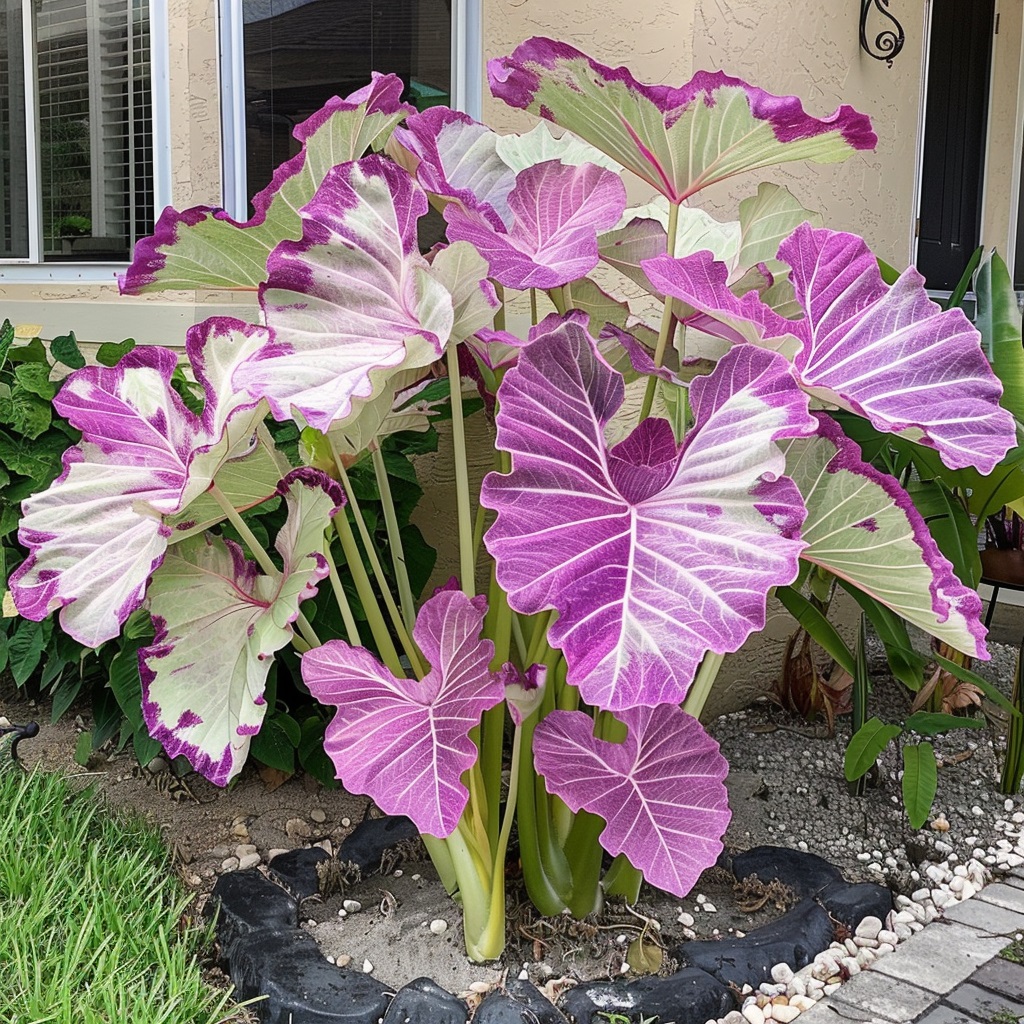The taro plant, with its distinctive heart-shaped leaves and edible corms, has been a staple in Polynesian and Asian cuisines for millennia. But amongst these diverse cultivars, the purple and white taro stands apart, not only for its striking appearance but also for its unique flavor and cultural significance. This article delves into the vibrant world of the purple and white taro, exploring its cultivation, culinary uses, cultural importance, and the potential health benefits it offers.

A Colorful History: Unraveling the Origins
The Taro Plant’s Ancestral Roots
The taro plant, scientifically known as Colocasia esculenta, is believed to have originated in Southeast Asia and the Malay Archipelago. It’s a member of the Araceae family, which includes plants like philodendrons and monsteras. For thousands of years, taro has been a fundamental food source for numerous cultures across the Pacific, Asia, and Africa.
The Emergence of the Purple and White Taro
The purple and white taro, specifically, is a more recent cultivar, likely arising through selective breeding in Polynesian cultures. Its vibrant hues and distinctive taste made it a prized addition to the diverse taro family. The exact origins of this specific variety remain shrouded in some mystery, yet its presence across the Pacific Islands, particularly in Hawaii and Samoa, offers a glimpse into its long-standing role in culinary traditions.

Tracing the Taro’s Global Expansion
As Polynesian cultures expanded across the Pacific, they carried the taro plant with them, introducing it to new regions and fostering its growth in diverse environments. This global migration of the taro plant, including the purple and white variety, has contributed to its widespread presence and cultural significance in many parts of the world.
Cultivation: Embracing the Tropical Climate
Thriving in Warm, Humid Environments
The purple and white taro thrives in warm, humid climates, showcasing its preference for tropical and subtropical environments. It requires well-drained, fertile soil, with a high water-holding capacity, making it an ideal candidate for regions experiencing consistent rainfall.
Propagation and Planting
Taro is typically propagated through corms, the underground storage organs that contain the plant’s vital nutrients. These corms are planted directly into the soil, ensuring a stable foundation for growth.
Sunlight and Watering Requirements
While it can tolerate partial shade, the purple and white taro thrives in full sunlight. A minimum of six hours of direct sun exposure is essential for healthy growth and vibrant coloration. Regular watering is crucial for taro, as it prefers a consistently moist environment. However, overwatering can lead to root rot, so proper drainage needs to be in place.
Maintenance and Pest Management
Taro plants require minimal maintenance. The primary focus lies in weeding and monitoring for pests and diseases. Vigilance in identifying and addressing any issues that arise is crucial for the plant’s overall health and productivity.
Culinary Delights: A Multifaceted Ingredient
The Versatility of the Taro Corm
The purple and white taro is a highly versatile ingredient, adding both flavor and color to a variety of dishes. Its unique characteristics lend themselves to both sweet and savory preparations, making it a staple in Polynesian, Hawaiian, and other Asian cuisines. The starchy corm is the most commonly consumed part of the plant, boasting a subtly sweet, nutty flavor profile, reminiscent of potatoes with a touch of earthiness.
| Texture | Flavor Profile |
| Soft and creamy when cooked | Subtly sweet, nutty, and earthy |
Culinary Applications of Taro Leaves
While the leaves are less commonly eaten compared to the corms, they can be used in certain dishes. When boiled or steamed, they offer a slightly bitter flavor and a fibrous texture, often incorporated into stir-fries and soups.
- Stir-fries
- Soups
- Stews
Popular Taro-Based Dishes
The purple and white taro finds its way into countless dishes, showcasing its versatility:
- Poi: A traditional Polynesian dish made from boiled taro corms, mashed to a smooth paste. Poi can be consumed plain or flavored with ingredients like coconut milk, fruit, or spices.
- Taro Chips: Thinly sliced and fried, taro chips offer a crispy snack with a delightful balance of sweetness and saltiness. They can be seasoned with various spices, herbs, or even chocolate.
- Taro Bread: A staple bread in many Polynesian cultures, taro bread is made from a combination of flour, taro corms, and other ingredients. It boasts a soft texture and a mild, sweet flavor.
- Taro Desserts: The purple and white taro’s natural sweetness and creamy texture lend themselves to delicious desserts. It’s often incorporated into cakes, puddings, ice cream, and other sweet treats.
Cultural Significance: A Legacy of Tradition
Hawaiian Mythology and the Taro Plant
In Hawaiian mythology, the taro plant is believed to have descended from the goddess Haumea. Its cultivation is viewed as a sacred act, with each stage of its growth carrying symbolic meaning. The taro’s life cycle is closely intertwined with the Hawaiian people’s spiritual and cultural identity.
Samoan Customs and the Taro’s Role
In Samoa, taro is a vital component of traditional ceremonies and cultural practices. It’s considered a symbol of respect and hospitality, often presented as a gift to honored guests. The taro’s significance extends beyond its culinary value, deeply rooted in Samoan traditions and social structures.
Taro’s Contribution to Food Security
For generations, taro has played a crucial role in food security, especially in regions where other crops struggle to thrive. Its resilience, adaptability, and nutritional value have ensured its continued importance as a staple food. The purple and white taro, in particular, has been a reliable source of sustenance for many Pacific Island communities.
Health Benefits: A Nutritious Choice
Fiber-Rich and Packed with Vitamins
The purple and white taro isn’t just a delicious staple; it’s also packed with valuable nutrients that contribute to overall health and well-being. Taro is a good source of dietary fiber, which aids digestion, promotes satiety, and helps manage blood sugar levels. It also contains essential vitamins like Vitamin C, thiamin, and riboflavin, along with minerals like iron, magnesium, and potassium.
Antioxidant Properties and Potential Benefits
Taro boasts a range of antioxidants, which help protect cells from damage caused by free radicals and contribute to overall health. While research is ongoing, some studies suggest potential benefits of taro consumption, such as improved cardiovascular health and cognitive function.
A Culinary Journey: The Future of Purple and White Taro
Taro as a Trendy Ingredient
The vibrant hues and versatility of the purple and white taro have captured the attention of chefs and food enthusiasts around the world, prompting its integration into more innovative and contemporary dishes. As the demand for unique and visually appealing ingredients continues to grow, the purple and white taro is poised to become a culinary sensation.
Sustainable Practices and the Taro’s Resurgence
The growing demand for sustainable and ethically sourced food has spurred a renewed interest in traditional crops like taro. Farmers are embracing sustainable practices, ensuring the future of this valuable food and preserving its cultural significance.
Global Recognition and the Taro’s Culinary Potential
The unique cultural story and culinary potential of the purple and white taro are gaining wider recognition, further solidifying its position as a global culinary gem. As the world becomes more interconnected, the appreciation for this versatile ingredient is expected to continue expanding, leading to new and exciting culinary explorations.
The purple and white taro, with its vibrant colors, distinctive taste, and profound cultural significance, stands as a testament to the interconnectedness of food, tradition, and health. From its origins in Polynesian cultures to its increasing global recognition, this versatile ingredient continues to inspire culinary innovation, nourish communities, and preserve cultural heritage. As we explore the ever-expanding world of food, the purple and white taro serves as a reminder of the profound connections between our plates and our planet, reminding us to savor the rich tapestry of flavors and traditions that bind us.





